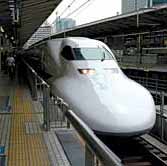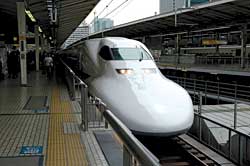
Seeing Double
New technologies can help put transportation security in focus
- By Scott Takaoka
- Jul 06, 2007
 TRANSPORTATION settings present challenging lighting, temperature and motion capture conditions for surveillance cameras. New image sensor technologies address the challenges to deliver image quality with wide dynamic range, low signal-to-noise ratio and progressive scan with a global electronic shutter. Cameras with new image sensor technologies provide a simple and effective method for integrators to deliver better transportation security systems.
TRANSPORTATION settings present challenging lighting, temperature and motion capture conditions for surveillance cameras. New image sensor technologies address the challenges to deliver image quality with wide dynamic range, low signal-to-noise ratio and progressive scan with a global electronic shutter. Cameras with new image sensor technologies provide a simple and effective method for integrators to deliver better transportation security systems.
Since 9/11, more than $24.5 billion in federal grants has been spent on improving security in transportation systems, such as airports, seaports, rail and transit systems. While airport security has received the most funding to date, more attention in Congress is now being focused on rail and transit security.
Recent events—such as the coordinated bombing attacks on Madrid trains in 2004, the London bus bombing attacks in July 2005, the devastating attacks in Mumbai, India, in July 2006, and the unexploded bombs found in two German railway stations in Dortmund and Koblenz in 2006—provide evidence of unaddressed vulnerabilities of security systems.
To help transit agencies combat threats, the Department of Homeland Security and other government agencies worldwide have identified CCTV, and specifically intelligent video systems made up of surveillance cameras, intelligent video software, video management applications and digital recording devices, as a critical technology infrastructure. Smart surveillance systems are specifically mentioned in the DHS Transit Security Grant Program as a potentially funded solution. It is clear DHS supports the vision that smart surveillance systems hold great promise in improving situational awareness beyond traditional CCTV systems.
Smart Surveillance Systems
Smart surveillance systems can provide a tremendous force-multiplier effect, allowing fewer security personnel to effectively cover a greater area. Getting the complex systems to function with high accuracy requires careful calibration with back-end intelligent video packages and the front end—the surveillance camera itself. The quality of image captured through the camera has an enormous impact on the accuracy of intelligent video software and on other performance metrics such as network bandwidth usage and video storage capacity.
Image quality is often overlooked as a key area for system performance because many integrators still struggle with the shortcomings of analog CCD sensor-based cameras. A new category of surveillance cameras with wide dynamic range is providing integrators with the opportunity to deliver improved image quality. Improvements can be measured in the ability to capture scenes not possible with traditional analog CCD cameras and the ability to provide accurate scene analysis from intelligent video applications. Leveraging wide dynamic range cameras within transportation applications provides a simple and effective method for integrators to deliver more value to customers.
Wide dynamic range refers to a camera’s ability to capture images with the highest ratio between highlights and shadows. This means not only being able to handle high-lux scenes without over saturation artifacts—blooming and smearing—but also an ability to perform in low-light conditions. Wide dynamic range is measured in decibels and as a general rule, a camera that provides 100 dB or greater is ideal for transportation environments.
Signal-to-noise ratio. While signal-to-noise provides a measure of the level of video noise, it also is the type of noise in the video signal. It is one of the largest determinants of how well captured images will look and compress.
Getting in the Algorithm
Intelligent video applications contain algorithms performing real-time image processing functions. The algorithms examine compressed or uncompressed video to differentiate between foreground and background, still and moving objects, what is and is not a target, and even if something is a video artifact or an event of interest.
Inherent to the algorithm’s function is a level of estimation based on what is seen. Intelligent video will produce a high-quality image with correct exposure for the entire scene in the highlights and shadows, high color fidelity, sharp imagery with maximum detail and low video noise. More data and a higher-quality video signal leads to reduced levels of estimation. Less estimation results in a reduction of false alarms and overall improvement in the accuracy of the scene analysis.
The ability for video images to be efficiently compressed, moved over IP networks and stored with sufficient quality is another important aspect of smart surveillance solution performance. In order to maintain viewable quality, the level of compression often has to be compromised with cameras that can provide only lower-quality images. A lack of image compressibility has a ripple effect, increasing storage requirements, consuming more network bandwidth and potentially limiting the number of implemented cameras.
Extreme Environments
Capturing quality images in transit and rail applications is difficult due to sometimes extreme environmental conditions. Two main environmental factors present a challenge for integrators.
• Extreme lighting conditions caused by the physical layout of rail and transit facilities—rail yards, indoor/outdoor transit stations, inaccessible underground subways—and installation constraints on mobile implementations, such as on buses, trains and light rails, to capture windows and doorways.
• Temperature extremes caused by implementation location, size constraints and form-factor requirements.
Because transit stations are designed to provide convenient, open access for passengers, along with aesthetic appeal, designs often incorporate large amounts of glass and open expansive areas, especially in indoor/outdoor boarding spots. While the areas may be pleasing to the eye, they can create many problems for smart surveillance systems.
Installed surveillance cameras must deal with constantly changing lighting conditions to capture faces on train platforms or entryways, and ensure doorways are clear of arms and limbs. Aluminum-shelled trains and shadowed overhangs, contrasted by a bright sunlight sky, only magnify extremes.
Analog CCD cameras struggle in these types of implementations. Due to the limited dynamic range of CCD sensors in high-lux settings, oversaturation of sensors is easily reached resulting in a number of detrimental video artifacts. Blooming occurs when there is loss of color fidelity or inability to distinguish one color from another. Image smearing occurs when large portions of captured images are lost and appear as a white band, completely lacking in any detail.
Savvy installers have had no choice but to compromise the implementation due to deficiencies. Stopping down the iris or using backlight compensation on CCD-based cameras to better manage hard-to-capture scenes only band aids the problem. Both of the techniques knock down highlights in an image, but do so with a loss of luminance and detail, especially in low-light areas. Less light coming into the camera also means less data. Less data not only leads to a sub-optimized picture, but also results in less accuracy of the intelligent video solution further down the chain.
Feel the Heat
Temperature fluctuations present another challenge for transit and rail system security camera performance. Heat is a significant issue, whether cameras are pole-mounted in rail yards in direct sunlight for perimeter security or installed in underground rail tubes with little ventilation.
Heat causes reliability issues with mechanical objects, such as DC iris lenses, and has detrimental effects on video quality. Analog CCD image sensors, like other semiconductors, become less efficient as temperatures rise.
Heat build up on the sensor chip causes cross-talk between analog circuits and is the main source of video noise. Video noise has a detrimental effect on picture quality and increases latency of intelligent video. It also requires more processing resources from an intelligent camera or a server. Intelligent video applications have to work harder to compensate the video signal noise that may look like anomalous behavior. Consequently, intelligent video applications must apply filtering techniques, taking up precious processing time to compensate for the noisy images captured by analog CCD image sensors.
Moving Targets
Mobile applications may be the most challenging for analog CCD sensor-based cameras because inherent limited dynamic range impedes the ability to handle rapidly changing lighting conditions. On-board, door-facing cameras must manage video exposure from fluorescent-lighted interiors with tinted windows, then quickly adapt to a door opening in direct sunlight, where the light values could be up to 20,000 times brighter. In addition, the camera must still be able to perform key imaging requirements, such as capturing faces of those entering the vehicle with correct color and white balance.
The usefulness also is limited in other applications, such as forward-facing cameras positioned to capture traffic events and driver response. Interlace artifacts, appearing as sawtooth edges, show up with objects in motion.
More detrimental to image quality is the inability of the sensors to properly render color and luminance in mobile lighting conditions. For example, such inaccuracies can make a difference in determining the status of a signal light in the case of a traffic accident.
Awareness of camera deficiencies has been growing and is evident in the rise of wide dynamic range cameras. A survey of major camera vendors reveals the technology hit the mainstream. Nearly all of the manufacturers have at least one camera in their line, and many have multiple wide dynamic range models.
Employing DPS
New sensor technology breakthroughs are one important factor in fueling the shift. Digital pixel system (DPS) technology moves the conversion of captured light (analog) to digital format at the source of capture. The change allows cameras with the technology to avoid many of the pitfalls of analog CCD sensors.
Integrators implementing transportation systems should consider cameras with DPS technology as improvements.
DPS image sensors are inherently low noise because the conversion to digital format takes place at the pixel level and can be controlled independently for saturation. The technology also supports non-destructive readout of the pixel, which avoids random background noise detectable with the human eye. This random noise also makes a huge difference in image compression. A 10x difference in compression ratios is not uncommon, especially when comparing images captured at night with high-video gain. Compression ratio, in turn, has a huge impact on overall cost of operations.
DPS also will provide cleaner images without interlace or motion artifacts compared to analog CCD imagers. Cleaner, artifact-free images containing more data will yield more accurate results from intelligent video applications.
When integrating surveillance solutions and architectures for transportation applications, users must provide imaging solutions that can readily adapt to varied environments, not all of which can be controlled. Integrators are best served by deploying camera solutions not limited by the camera’s image sensor.
To take advantage of the flexibility of solutions, installers should look to cameras with newer, all-digital sensor solutions that can deliver high, overall image quality with low noise, color fidelity and the widest dynamic range possible. Choosing camera solutions with these parameters will provide superior visual images and improve overall performance of today’s intelligent surveillance solutions.